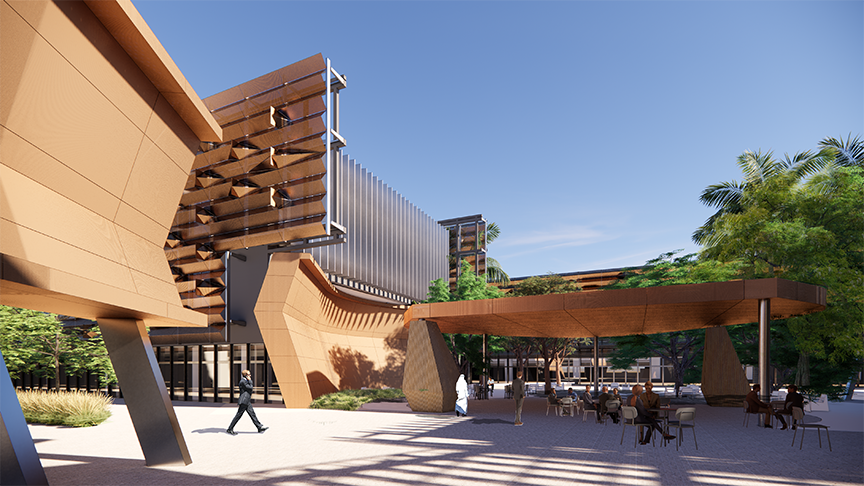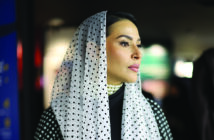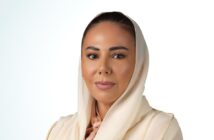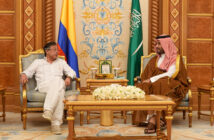As Saudi Arabia prepares for a sustainable, prosperous future with its transformation under the Vision 2030 initiative, the United States has been upgrading its diplomatic presence across the Kingdom, a testament to the durability of the U.S.-Saudi partnership that extends over eight decades. There are new U.S. consulates in Jeddah and Dhahran, and the new U.S. Embassy in Riyadh under construction in the Diplomatic Quarter will provide enhanced facilities for Embassy staff and their families, as well as improved services to the thousands of U.S. citizens living in Saudi Arabia, and travelers.
These developments prompted a discussion with the U.S. Ambassador to Saudi Arabia, H.E. Michael Ratney. A distinguished career diplomat with over three decades of diplomatic service, Ambassador Ratney shared his perceptions of the transformation taking place in Saudi Arabia and the expanding U.S.-Saudi partnership.
Volumes could be written about the depth of U.S.-Saudi relations. If we narrow the scope, can you reflect on the most significant achievements of the last few years? Where do you see potential for the expansion; in education, space, arts?
The relationship between the United States and Saudi Arabia is in an excellent place. And one of the exciting things about being the U.S. Ambassador to Saudi Arabia right now is witnessing the rapid pace of change in the Kingdom. The economy is diversifying, the society is evolving, and the United States can certainly be part of that remarkable change. If once upon a time, the opportunities and the basis of the relationship were in the energy sector and the defense sector, now what is really amazing is how diverse the relationship has become, owing to the multitude of new opportunities for partnership.
For example, the scope for cooperation has expanded to allow for civil and commercial space cooperation. I do not think anyone would have imagined ten years ago that this would be at the center of Saudi Arabia’s ambitions, but now it is. And U.S. companies are part of it, this Embassy is part of it. Last year, two Saudi astronauts Rayyanah Barnawi and Ali Al-Qarni traveled to space with us as part of the Axiom 2 mission. We just hosted the head of NASA here a few months back, and he signed a framework agreement with Saudi Arabia on space exploration. So, this is an area of incredible opportunity for both our countries. In terms of media and television, in a place where once there were no movie theaters, now there is an emerging film community. You have Hollywood producers and filmmakers here, and there are young Saudi actors, directors and producers, and we are connecting them with Hollywood. In all these areas, we are bringing American and Saudi professionals as a new area of cooperation in the U.S.-Saudi partnership, and one that really speaks to the diversification of the relationship.
Another area of cooperation is education. Saudis have been studying in the United States for generations. Now, we talk to the Saudi government about two-way educational exchange. While we love that Saudi students come to the United States, we would also like to see more American students, faculty, and scholars come to the Kingdom. This will increase the volume of two-way educational exchange; it will be great for the United States and for Saudi Arabia, and will contribute to Saudi Arabia’s economic aspirations.
Last but not least, the sector that speaks volumes about the way the relationship has evolved is renewable energy. The United States was here from the very beginning of the Saudi oil industry and that was the origin story of the U.S.-Saudi relationship. Now, just a few months ago, U.S. Secretary of Energy Jennifer Granholm visited Saudi Arabia. While it seems normal for a U.S. Secretary of Energy to travel to Saudi Arabia, the topics of our discussions have changed. This time, the U.S. and Saudi counterparts were talking not about oil, but about hydrogen, carbon capture technology, solar energy, and all forms of renewable energy, and how the United States and Saudi Arabia can collaborate – not just in the present, but in the future of energy.
Taking into consideration the Saudi Vision of an oil-diversified economy by 2030, what would you consider as the main asset for the Kingdom other than oil? And why?
I would say first and foremost Saudi Arabia’s biggest asset is its people. This is true for almost all countries, and especially for countries with vast expectations and ambitions, like Saudi Arabia. The other asset is the ambition of the country itself. Saudi Arabia is an extremely ambitious country; it is a young country, a country with big plans to diversify, to fundamentally change some aspects of the society. I was here about ten or twelve years ago for the first time, and it feels very different now. Over the last year, I have felt an energy in the air – a young population filled with enthusiasm and a sense of the direction they are headed in, and they like that direction. So, you have a youth that is well-educated, literate, and embracing those ambitions. To me, that is as valuable and powerful a resource as oil has ever been.
As the U.S. Ambassador to Saudi Arabia, you head the embassy in Riyadh and oversee the two consulates in Jeddah and Dhahran. Please discuss your impression about these three regions of the Kingdom. What would you consider the strength of each region?
As an ambassador with three posts in one country, traveling within Saudi Arabia is a fundamental part of my job, and the diversity of the country only makes the importance of travel more compelling. I travel to Jeddah and Dhahran all the time, and from there I travel to other parts of the Kingdom as much as I can. My travels allow me to gain an appreciation for the sheer diversity of this country in a way that challenges anyone’s preconceptions about Saudi Arabia, including my own, before I came here.
Riyadh is an interesting place that is becoming bigger and an exciting city. A lot of work has been done in terms of infrastructure and city design to balance the preservation of historical heritage, such as at Diriyah or Masmak Fortress, while at the same time transforming the city into a modern world hub.
Dhahran is a very different place. Dhahran is the city where the first permanent U.S. diplomatic mission in the region opened in the 1930s, when oil was discovered, and of course Aramco was present. And it is still the only foreign diplomatic mission in the Eastern Province. Certainly, it is about a lot more than oil now – it is part of our cultural and commercial relations with that part of the country, and that region remains very important for our mission for a lot of reasons. The energy sector remains important, with a number of American companies operating in cities like Jubail. In fact, the Eastern Province has the largest concentration of American citizens in the Kingdom and that is my first order of business – looking after American citizens. I also had a chance to go to Hofuf and see a very different geography and a sense of how that fits with Saudi Arabia’s history. I visited Ithra and got to see the incredible Museum that Aramco started. So, there is a lot going on there, but because people tend to think of the Eastern Province as an oil hub, they tend to miss other aspects of this part of Saudi Arabia.
And Jeddah – Jeddah is just an amazing city. We have had a diplomatic mission in Jeddah dating back to even before the Saudi state, because it is a very important part of the region, close to Mecca and Medina, with pilgrims from all over the world. It became an important commercial center. I would say it is the second capital of Saudi Arabia, and we get a lot of visitors from Washington, D.C. visiting Jeddah as well, especially when Saudi government officials are in residence there. It was in Jeddah and throughout western Saudi Arabia that I experienced the full diversity of the Kingdom; and I have traveled a lot there – from Jazan and Abha in the south to Medina to Al Ula to Tabuk. This part of the Kingdom can blow people’s minds when they see the beauty and diversity of the country.

A rendering of the new U.S. Embassy.
What about the mission buildings? Would you say that they are part of Saudi Arabia’s history?
Interestingly, all the U.S. mission buildings in the Kingdom have truly become part of Saudi Arabia’s history. Although the new consulate buildings in Jeddah and Dhahran were commissioned a few years ago, the old ones still fit in well with the overall skyline of these cities, they are charming. And the fact that the United States is investing in building and designing new facilities for its missions shows that this is about much more than energy; it is about maintaining our diplomatic presence in an important part of the country.
The new U.S. Embassy in Riyadh that we are building in the Diplomatic Quarter will reflect American values and the best in American architecture, design, engineering, technology, and sustainability, adjacent to the landscape of Wadi Hanifa. I tell Saudis, if they ever doubt the durability of our partnership, all they need to do is look at our blueprints for the big, modern new Embassy we are building. The scale and ambition of this project, together with its innovative design, are emblematic of the big, ambitious bilateral relationship that our Embassy team here is building every single day.
Beyond the clichés, what would be your exclusive “selling” point for why Saudis should visit the United States, and what makes the Kingdom an attractive destination for Americans?
One of the main reasons Saudis have traveled and should continue to travel to the United States is education, as we have some of the best universities and research centers in the world. The United States education system offers a whole variety of specialized schools and choices for all professions and skills at the undergraduate, graduate and postgraduate levels, which I believe Saudis value. Vacation is a second reason to travel to the USA. Saudis will find everything they are looking for: from mountain hiking to ocean fronts, from Las Vegas to bustling New York City to a huge network of national parks and reserves. Saudis have a great opportunity to experience both active and relaxing holidays in one country; if they like nature, they can experience that, or they can get on a plane and go to New York or Los Angeles and see some of the biggest, most dynamic cities. Another reason is career advancement and experience. Some Saudis work in the United States for many years and bring their acquired knowledge and experience back to the Kingdom. Many are attracted to our very dynamic tech sector in California and elsewhere. So, the sheer diversity of the United States is a huge attraction.
As for Saudi Arabia, I always encourage people to travel to the Kingdom. It is fascinating to watch visitors explore and discover Saudi Arabia with their own eyes, because often people from the outside cannot truly appreciate the country. They come to Riyadh, a big city in the Middle East, and then they start traveling around the country. They discover Al Ula or Medina or the Asir Mountains; and then they realize that Saudi Arabia is quite unlike anything they imagined. They imagined desert, but they never imagined high green mountains or ancient archaeological sites. Sometimes, people who travel to Saudi Arabia are simply surprised at how friendly the people are. I experienced a great sense of hospitality from Saudis who enjoy the fact that Americans or other foreigners come to the Kingdom to explore it.
After more than a year in the Diplomatic Quarter, what will be your remarks about this concept?
While our job as diplomats is to serve in foreign countries, learn about new places, interact with these new countries, and make that our professional life, we are also thousands of miles from our homes. And everyone is looking for community. The Diplomatic Quarter makes a very comfortable community – it feels like a small village – a pleasant place to live, with all the necessary amenities of modern life. It is a really nice community and I know it will get bigger at some point, but for now I love living in Diplomatic Quarter. One of my responsibilities as Ambassador is to encourage American diplomats to work at the Embassy in Riyadh, and one of the perks I always mention is the opportunity to live in the Diplomatic Quarter.




